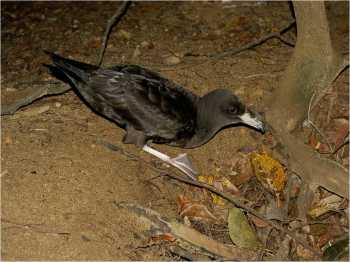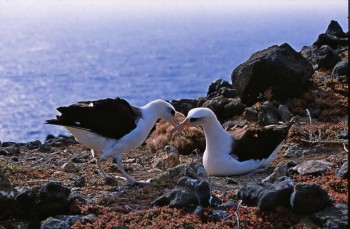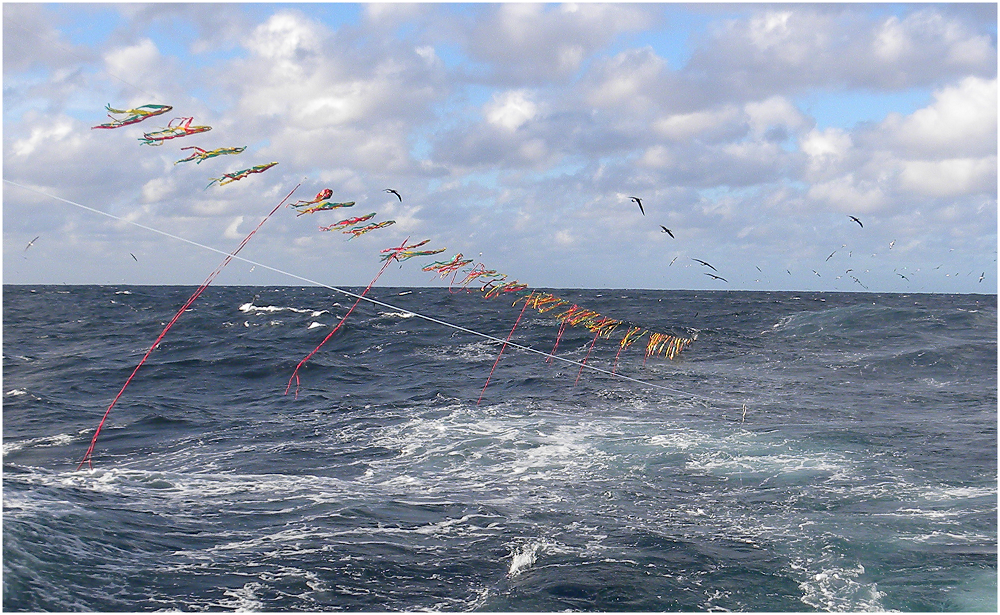The United Kingdom’s Royal Society for the Protection of Birds (RSPB) announced last week that the long-awaited attempt to eradicate introduced House Mice Mus musculus on Gough Island in the South Atlantic is set to take place in 2019 (click here).
Gough’s oversized “killer” mice have become well known for their attacks on seabird chicks on the island, leading most notably to unsustainably low breeding success for the near endemic and globally Critically Endangered Tristan Albatross Diomedea dabbenena and the endemic and globally Endangered Atlantic Petrel Pterodroma incerta. Both species rear their chicks in winter when alternative food sources for mice are scarce. Other seabird species on the island, especially the burrowing petrels, are also known or thought to be impacted by mice.
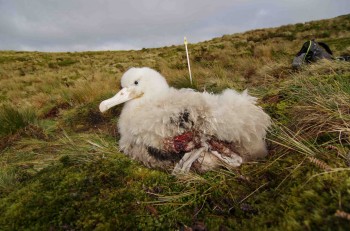
A Tristan Albatross chick close to death after being eaten alive by mice, photograph by Sylvain Dromzee & Karen Bourgeois
“While we still have a funding shortfall, thanks to generous financial support from the UK Government, the [USA's] National Fish and Wildlife Foundation and other sources, we are now sufficiently confident to plan the mouse eradication operation to start in 2019.” Contributions to the costs of the operation can be made via an appeal by the RSPB (click here).
Read more about the RSPB’s Gough Island Restoration Programme here.
The go-ahead announcement was also made by the United Kingdom Delegation to the 4th Meeting of ACAP's Population and Conservation Working Group held in Wellington, New Zealand earlier this month. The news was met with warm support from the working group (See AC10 Doc 11 Rev 1).
The decision to attempt a mouse eradication by poison bait drop was made after over a decade of concerted research on the island by UK and South African scientists, resulting in a large suite of papers and reports on the impacts of mice on Gough’s seabirds and that address questions towards their eradication raised by a feasibility study by New Zealand eradication expert, John Parkes. A selected list of these publications follows.
Click here to access the over a hundred previous articles in ACAP Latest News on Gough’s mice and their depredations on the island’s avifauna.
Selected Literature:
Angel, A. & Cooper, J. 2006. A review of the impacts of introduced rodents on the Islands of Tristan da Cunha and Gough (South Atlantic). RSPB Research Report No. 17. Sandy: Royal Society for the Protection of Birds. 64 pp.
Angel, A, Wanless, R.M. & Cooper, J. 2008. Review of impacts of the introduced House Mouse on islands in the Southern Ocean: are mice equivalent to rats? Biological Invasions 11: 1743-1754.
Anon. 2016. Gough Island Restoration Project. Sandy: Royal Society for the Protection of Birds. 22 pp.
Cooper, J., Cuthbert, R.J. & Ryan, P.G. 2013. An overlooked biosecurity concern? Back-loading at islands supporting introduced rodents. Aliens: The Invasive Species Bulletin 33: 28-31.
Cuthbert, R,[J.] & Hilton, G. 2004. Introduced house mice Mus musculus: a significant predator of threatened and endemic birds on Gough Island, South Atlantic Ocean? Biological Conservation 117: 483-489.
Cuthbert, R.J., Broome, K., Bradley, J. & Ryan, P.G. 2014. Evaluating the effectiveness of aerial baiting operations for rodent eradications on cliffs on Gough Island, Tristan da Cunha. Conservation Evidence 11: 25-28.
Cuthbert, R.J., Cooper, J. & Ryan, P.G. 2013. Population trends and breeding success of albatrosses and giant petrels at Gough Island in the face of at-sea and on-land threats. Antarctic Science 26: 163-171.
Cuthbert, R.J., Louw, H., Lurling, J. & Parker, G. 2013. Low burrow occupancy and breeding success of burrowing petrels at Gough Island: a consequence of mouse predation. Bird Conservation International 23: 113-124.
Cuthbert, R.J., Louw, H., Parker, G., Rexer-Huber, K. & Visser, P. 2013. Observations of mice predation on dark-mantled sooty albatross and Atlantic yellow-nosed albatross chicks at Gough Island. Antarctic Science 25: 763-766.
Cuthbert, R.J., Parker, G., Louw, H., Rexer-Huber, K., Parker, G. & Ryan, P.G. 2011. Preparations for the eradication of mice from Gough Island: results of bait acceptance trials above ground and around cave systems. In: Veitch, C.R.,Clout, M.N. & Towns, D.R. (Eds). Island Invasives: Eradication and Management. Gland, Switzerland: IUCN. pp. 47-50.
Cuthbert, R.J., Visser, P., Louw, H. & Ryan, P.G. 2011. Palatability and efficacy of rodent baits for eradicating house mice (Mus musculus) from Gough Island, Tristan da Cunha. Wildlife Research 38: 196-203.
Cuthbert, R.J., Wanless, R.M., Angel, A., Burlé, M.-H., Hilton, G.M., Louw, H., Visser, P., Wilson, J. & Ryan, P.G. 2016. Drivers of predatory behaviour and extreme body size in House Mice Mus musculus on Gough Island. Journal of Mammalogy 97: 533-544.
Davies, D., Dilley, B.J., Bond, A.L., Cuthbert, R.J. & Ryan, P.G. 2015. Trends and tactics of mouse predation on Tristan Albatross Diomedea dabbenena chicks at Gough Island, South Atlantic Ocean. Avian Conservation and Ecology 10(1): 5. doi.org/10.5751/ACE-00738-100105.
Dilley, B.J., Davies, D., Bond, A.L. & Ryan, P.G. 2015. Effects of mouse predation on burrowing petrel chicks at Gough Island. Antarctic Science 27: 543-553.
Parkes, J. 2008. A Feasibility Study for the Eradication of House Mice from Gough Island. RSPB Research Report No. 34. Sandy: Royal Society for the Protection of Birds. 52 pp.
Rexer‐Huber, K. & Parker, G. 2011. Captive Husbandry of the Gough Island Bunting and Moorhen. RSPB Research Report No. 42. Sandy: Royal Society for the Protection of Birds. 51 pp.
Ryan, P.G. & Cuthbert, R.J. 2008. The biology and conservation status of Gough Bunting Rowettia goughensis. Bulletin of the British Ornithologists' Club. 128: 242-253.
Tucker, G.M. & Underwood, E. 2016. Gough Island: an Assessment of its Status and Case for inclusion on the List of World Heritage in Danger. London: Institute for European Environmental Policy.40 pp.
Wanless, R.M., Angel, A., Cuthbert, R.J., Hilton, G.M. & Ryan, P.G. 2007. Can predation by invasive mice drive seabird extinctions? Biology Letters 3: 241-244.
Wanless, R.M., Angel, A., Hilton, G.M. & Ryan, P.G. 2005. Cultural evolution in the introduced house mouse: evidence for the cultural transmission of a unique predatory behaviour on Gough Island. Paper delivered at the 19th Annual Meeting of the Society for Conservation Biology Conference, Brasília, Brazil, 15-19 July 2005.
Wanless, R.M., Fisher, P., Cooper, J., Parkes. J. & Ryan, P.G. 2008. Bait acceptance by house mice: an island field trial. Wildlife Research 35: 806-811.
Wanless, R.M., Ryan, P.G., Altwegg, R., Angel, A., Cooper, J., Cuthbert, R. & Hilton, G.M. 2009. From both sides: dire demographic consequences of carnivorous mice and longlining for the critically endangered Tristan albatrosses on Gough Island. Biological Conservation 142: 1710-1718.
Wanless, R.M., Cooper, J., Slabber, M.J., & Ryan, P.G. 2010. Risk assessment of birds foraging terrestrially at Marion and Gough Islands to primary and secondary poisoning. Wildlife Research 37: 524-530.
Wanless, R.M., Ratcliffe, N., Angel, A., Bowie, B.C., Cita, K., Hilton, G.M., Kritzinger, P., Ryan, P.G. & Slabber, M. 2012. Predation of Atlantic petrel chicks by house mice on Gough Island. Animal Conservation 15: 472-479.
With thanks to John Kelly and Clare Stringer for information.
John Cooper, ACAP Information Officer, 29 September 2017, updated 02 October 2917
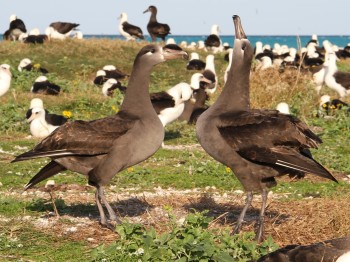

 English
English  Français
Français  Español
Español 
